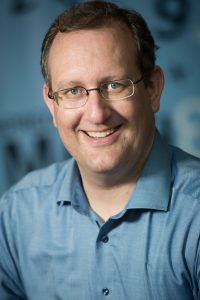HITS researcher Christoph Pfrommer is new professor at the AIP Potsdam
As of April 1, 2017, the astrophysicist is leading the research group Cosmology and Large-scale Structure at the Leibniz Institute for Astrophysics Potsdam (AIP) and professor for astrophysics at the University of Potsdam. Pfrommer worked at HITS since 2010, did his habilitation there and earned a ERC Consolidator Grant that enabled him to build up his own junior research group.
How do galaxies and galaxy clusters, which are among the largest structures in the universe, form? Do cosmic rays have an impact on galaxy and cluster formation? Prof. Dr. Christoph Pfrommer is seeking answers to these questions. Starting in April, Pfrommer is leading the research group Cosmology and Large-scale Structure at the Leibniz Institute for Astrophysics Potsdam (AIP) and doing research as a jointly appointed professor at the University of Potsdam. The astrophysicist has moved to Potsdam from the HITS, the Heidelberg Institute for Theoretical Studies.
Cosmic rays originate in supernova explosions and jets erupting from supermassive black holes. “Aside from the fascinating question regarding the origin of cosmic rays, we especially want to find out whether they play a decisive role in galaxy formation,” says Pfrommer. The gaseous outflows that are powered by cosmic rays could be an important aspect in the development of spiral galaxies and may limit the amount of newborn stars in elliptical galaxies. Pfrommer and his research group model the underlying physics of cosmic rays, magnetic fields, and plasma waves in great detail with the goal to conduct cosmological simulations at high resolution on supercomputers. They validate their results by comparing their simulations to observations of radio and gamma-ray telescopes.
Pfrommer studied physics at the Friedrich Schiller University in Jena, Germany. In 2005, he obtained his PhD at the Ludwig-Maximilians-Universität München, with a doctoral thesis on the role of cosmic rays in clusters of galaxies. Afterwards, he worked at the Canadian Institute for Theoretical Astrophysics in Toronto, Canada, as a postdoctoral research fellow and, since 2010, at the HITS in Heidelberg, Germany. He was also a visiting fellow at the Max Planck Institute for Astrophysics, Garching, Germany, as well as at Stanford University and the Kavli Institute for Theoretical Physics in Santa Barbara, USA. In 2014, he obtained an ERC Consolidator Grant by the European Research Council for his project CRAGSMAN, which is investigating the impact of cosmic rays on galaxy and cluster formation. He used the €2 million research grant to establish his own group “High Energy Astrophysics and Cosmology” (HAC). The group will stay at HITS until summer 2017 and then also move to Potsdam.
Scientific Contact:
Prof. Dr. Christoph Pfrommer
Leibniz Institute for Astrophysics Potsdam
cpfrommer@aip.de
Media contact:
Katrin Albaum
Leibniz Institute for Astrophysics Potsdam
Tel. +49 331-7499 803
presse@aip.de
Leibniz Institute for Astrophysics Potsdam (AIP)
The key areas of research at the Leibniz Institute for Astrophysics Potsdam (AIP) are cosmic magnetic fields and extragalactic astrophysics. A considerable part of the institute’s efforts aim at the development of research technology in the fields of spectroscopy, robotic telescopes, and e-science. The AIP is the successor of the Berlin Observatory founded in 1700 and of the Astrophysical Observatory of Potsdam founded in 1874. The latter was the world’s first observatory to emphasize explicitly the research area of astrophysics. The AIP has been a member of the Leibniz Association since 1992.
[post-content shortcodes=”1″ id=”13190″]
About HITS
HITS, the Heidelberg Institute for Theoretical Studies, was established in 2010 by physicist and SAP co-founder Klaus Tschira (1940-2015) and the Klaus Tschira Foundation as a private, non-profit research institute. HITS conducts basic research in the natural, mathematical, and computer sciences. Major research directions include complex simulations across scales, making sense of data, and enabling science via computational research. Application areas range from molecular biology to astrophysics. An essential characteristic of the Institute is interdisciplinarity, implemented in numerous cross-group and cross-disciplinary projects. The base funding of HITS is provided by the Klaus Tschira Foundation.
